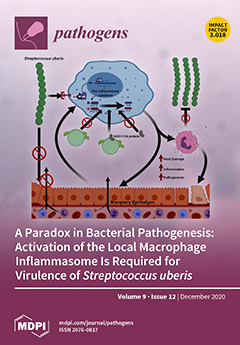Wheat (
Triticum aestivum) is one of the most economically important crops in the world. During the routine monitoring of wheat pest, the cereal leaf beetle (CLB,
Oulema melanopus, Coleoptera, Chrysomelidae), in the Greater Poland region, it was observed that some leaves
[...] Read more.
Wheat (
Triticum aestivum) is one of the most economically important crops in the world. During the routine monitoring of wheat pest, the cereal leaf beetle (CLB,
Oulema melanopus, Coleoptera, Chrysomelidae), in the Greater Poland region, it was observed that some leaves wounded by CLB also displayed brownish lesions with clear margins and yellow halo, disease symptoms resembling a bacterial infection. The aim of this study was therefore to investigate those symptoms to establish a causal agent of the disease. The identification based on the results of the Biolog’s Gen III system, 16S rRNA, and
gyrB genes sequencing, revealed the presence of eight strains of
Pantoea ananatis bacteria. Four strains were derived from wheat leaves (Ta024, Ta027, Ta030, Ta046), and four from the CLB’s oral secretion (OUC1, OUD2, OUF2, and OUG1). They shared the nucleotide identity ranging from 99 to 100% to
P. ananatis strains deposited in the GenBank database. Additionally, the multi-locus sequence analysis (MLSA) of concatenated sequences of partial
atpD,
fusA,
gyrB,
rplB, and
rpoB genes was performed. All
P. ananatis strains isolated in Poland, grouped into one cluster supported with high bootstrap value. Pathogenicity tests performed on four varieties of wheat plants have identified
P. ananatis strains as a causal agent of wheat disease. To our knowledge, this is the first report of
P. ananatis affecting wheat plants.
Full article






